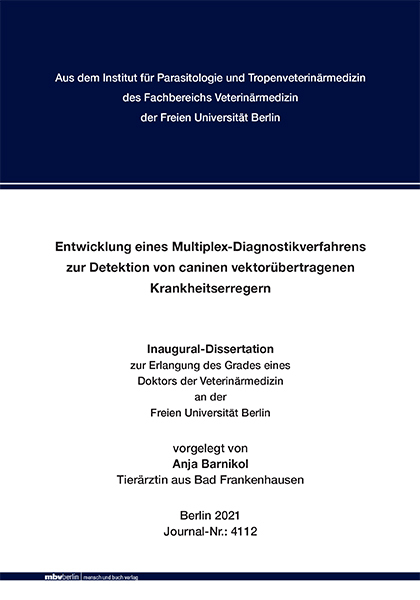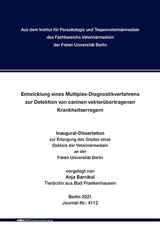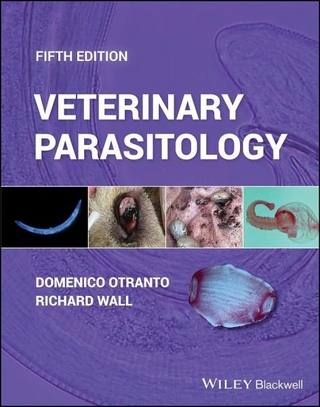Entwicklung eines Multiplex-Diagnostikverfahrens zur Detektion von caninen vektorübertragenen Krankheitserregern
Seiten
2021
|
1. Aufl.
Mensch & Buch (Verlag)
9783967291292 (ISBN)
Mensch & Buch (Verlag)
9783967291292 (ISBN)
- Keine Verlagsinformationen verfügbar
- Artikel merken
Die Weiterentwicklung von Diagnostikmethoden und die Generierung epidemiologischer Daten sind im Zusammenhang mit caninen vektorübertragenen Erkrankungen wichtige Voraussetzungen, um Infektionsrisiken einzuschätzen, geeignete Prophylaxe- und Therapiemaßnahmen zu ergreifen und somit die Verbreitung dieser Krankheitserreger einzudämmen. Im Rahmen dieser Arbeit wurde erstmals eine Triplex-PCR zur simultanen Detektion von caninen vektorübertragenen Erregern der Familie Onchocercidae sowie Anaplasmataceae und der Ordnung Piroplasmida entwickelt. Darauf aufbauend wurde mit der Etablierung einer Multiplex-Diagnostikmethode auf Basis der Luminex®-xMAP®-Technologie begonnen. Diese sollte zur Speziesdifferenzierung der Erreger dienen, die mit der Multiplex-PCR nachgewiesen wurden. In diesem Projekt lag der Fokus auf der Differenzierung der caninen Pathogene Babesia canis, Babesia vogeli, Babesia gibsoni, Anaplasma phagocytophilum, Ehrlichia canis, Candidatus Neoehrlichia mikurensis, Rickettsia conorii und Dirofilaria immitis. Der Versuch die Triplex-PCR mit einem zusätzlichen Primerpaar zum Nachweis von Rickettsia spp. auf ein Quadruplex-Verfahren zu erweitern, wurde abgebrochen, da die Methode im Vergleich zur Triplex-PCR weniger zuverlässige Ergebnisse liefern konnte. Im Rahmen der Entwicklung der genannten Diagnostikmethoden wurden 246 Blutproben von Hunden aus den Ländern Ungarn, Griechenland, Mazedonien, Bosnien-Herzegowina und Israel gesammelt und zum vereinfachten Transport sowie zur Konservierung auf FTA®-Karten archiviert. Zur Probengewinnung wurden Länder gewählt, in denen die ausgewählten Erreger endemisch sind. Die Beprobung wurde vor Ort bei Hunden durchgeführt, bei denen der Verdacht auf eine Infektion mit einem der hier relevanten Krankheitserreger bestand. Mittels eines DNAExtraktionsverfahrens wurden die Nukleinsäuren aus der Matrix des FTA®-Papiers isoliert und mit der Triplex-PCR sowie teilweise mit der Quadruplex-PCR untersucht. Aufgrund der Diskrepanz zwischen den Ergebnissen der beiden Verfahren sowie der scheinbar geringeren Sensitivität und Spezifität der Quadruplex-PCR im Vergleich zur Triplex-PCR wurde die Quadruplex-PCR ausschließlich bei 204 der 246 Proben angewandt. Die Blutproben aus Israel waren ausschließlich zur Verwendung im Etablierungsprozess der Diagnostikverfahren vorgesehen, da sie von Hunden stammten, die zum Beprobungszeitpunkt bereits mit vektorübertragenen Erkrankungen diagnostiziert waren.
Das speziesspezifische Multiplex-Diagnostikverfahren auf Basis der Luminex®-xMAP®-Technologie konnte in dem gegebenen Zeitrahmen nicht vollständig etabliert werden. Nach Durchführung einiger Modifikationen hinsichtlich der Kopplungs- und Hybridisierungsverfahren, wäre jedoch ein sensitiver und spezifischer Nachweis der hier ausgewählten Pathogene sowie eine Erweiterung des Assays auf weitere Erreger, basierend auf der beschriebenen Triplex-PCR, möglich. Development of a multiplex diagnostic method for detection of canine vector-borne pathogens
In order to assess infection risks, take prophylactic as well as therapeutic measures and thus keep infectious agents from spreading, continued efforts concerning the development of diagnostic methods and generation of epidemiologic data related to canine vector-borne diseases are required. In this study a triplex PCR for the simultaneous detection of canine vector-borne pathogens of the taxonomic family Onchocercidae and Anaplasmataceae as well as the order Piroplasmida was developed for the first time. Additionally the establishment of a multiplex diagnostic method based on the Luminex®-xMAP®-Technology was described, aiming at the determination and differentiation of nine canine target species (Babesia canis, Babesia vogeli, Babesia gibsoni, Anaplasma phagocytophilum, Ehrlichia canis, Candidatus Neoehrlichia mikurensis, Rickettsia conorii and Dirofilaria immitis), previously detected using the multiplex PCR. An effort to extend the triplex PCR into a quadruplex PCR by including an additional pair of primers designed to specifically detect Rickettsia spp. was made but discontinued because results obtained with the quadruplex PCR were less reliable compared to the triplex PCR results. In total 246 blood samples, collected from dogs in Hungary, Greece, Macedonia, Bosnia Herzegovina and Israel, were conserved on FTA® Cards in order to achieve easier transport and storage. Countries participating in the sampling procedure were chosen according to the known occurrence of the above mentioined target species in their canine populations. Samples were obtained from dogs that were suspected to be infected with either of the pathogens of interest. Nucleic acids were isolated from the matrix of the FTA® Cards using a DNA extraction method and subsequently examined with the triplex PCR and partly with the quadruplex PCR. Due to mismatching results of the quadruplex-PCR and its suspected lower sensitivity and specifity in comparison to the triplex-PCR only 204 of the 246 samples were examined with the quadruplex method. The non-representative results of both PCR assays were statistically analysed and the frequency of occurences of the canine pathogens within the samples were compared between different countries, indicating similar levels of infection for all participating regions. This may be explained by similar climatic conditions and similar vector distributions. Blood samples from Israel were used soley for the establishment of the diagnostic assays since they were obtained from dogs previously diagnosed with afore mentioned canine vector borne pathogens. Therefore, they were not included in the statistical analysis. All collected samples were obtained using a non-randomised sampling procedure and subsequently are not representative regarding country specific prevalences. However, they can be considered as a basis for further epidemiological investigation. The specific multiplex assay using the Luminex® xMAP® technology was not completely established within the timeframe set for this study. However, following further modifications regarding the process of coupling and hybridisation it may be used as a sensitive and specific method for the detection of the target canine pathogens and be extended towards the detection and quantification of more pathogens, using the described triplex PCR as a basis.
Das speziesspezifische Multiplex-Diagnostikverfahren auf Basis der Luminex®-xMAP®-Technologie konnte in dem gegebenen Zeitrahmen nicht vollständig etabliert werden. Nach Durchführung einiger Modifikationen hinsichtlich der Kopplungs- und Hybridisierungsverfahren, wäre jedoch ein sensitiver und spezifischer Nachweis der hier ausgewählten Pathogene sowie eine Erweiterung des Assays auf weitere Erreger, basierend auf der beschriebenen Triplex-PCR, möglich. Development of a multiplex diagnostic method for detection of canine vector-borne pathogens
In order to assess infection risks, take prophylactic as well as therapeutic measures and thus keep infectious agents from spreading, continued efforts concerning the development of diagnostic methods and generation of epidemiologic data related to canine vector-borne diseases are required. In this study a triplex PCR for the simultaneous detection of canine vector-borne pathogens of the taxonomic family Onchocercidae and Anaplasmataceae as well as the order Piroplasmida was developed for the first time. Additionally the establishment of a multiplex diagnostic method based on the Luminex®-xMAP®-Technology was described, aiming at the determination and differentiation of nine canine target species (Babesia canis, Babesia vogeli, Babesia gibsoni, Anaplasma phagocytophilum, Ehrlichia canis, Candidatus Neoehrlichia mikurensis, Rickettsia conorii and Dirofilaria immitis), previously detected using the multiplex PCR. An effort to extend the triplex PCR into a quadruplex PCR by including an additional pair of primers designed to specifically detect Rickettsia spp. was made but discontinued because results obtained with the quadruplex PCR were less reliable compared to the triplex PCR results. In total 246 blood samples, collected from dogs in Hungary, Greece, Macedonia, Bosnia Herzegovina and Israel, were conserved on FTA® Cards in order to achieve easier transport and storage. Countries participating in the sampling procedure were chosen according to the known occurrence of the above mentioined target species in their canine populations. Samples were obtained from dogs that were suspected to be infected with either of the pathogens of interest. Nucleic acids were isolated from the matrix of the FTA® Cards using a DNA extraction method and subsequently examined with the triplex PCR and partly with the quadruplex PCR. Due to mismatching results of the quadruplex-PCR and its suspected lower sensitivity and specifity in comparison to the triplex-PCR only 204 of the 246 samples were examined with the quadruplex method. The non-representative results of both PCR assays were statistically analysed and the frequency of occurences of the canine pathogens within the samples were compared between different countries, indicating similar levels of infection for all participating regions. This may be explained by similar climatic conditions and similar vector distributions. Blood samples from Israel were used soley for the establishment of the diagnostic assays since they were obtained from dogs previously diagnosed with afore mentioned canine vector borne pathogens. Therefore, they were not included in the statistical analysis. All collected samples were obtained using a non-randomised sampling procedure and subsequently are not representative regarding country specific prevalences. However, they can be considered as a basis for further epidemiological investigation. The specific multiplex assay using the Luminex® xMAP® technology was not completely established within the timeframe set for this study. However, following further modifications regarding the process of coupling and hybridisation it may be used as a sensitive and specific method for the detection of the target canine pathogens and be extended towards the detection and quantification of more pathogens, using the described triplex PCR as a basis.
| Erscheinungsdatum | 24.09.2021 |
|---|---|
| Verlagsort | Berlin |
| Sprache | deutsch |
| Maße | 148 x 210 mm |
| Gewicht | 400 g |
| Themenwelt | Veterinärmedizin ► Allgemein |
| Veterinärmedizin ► Klinische Fächer ► Parasitologie | |
| Schlagworte | Anaplasma phagocytophilum • anaplasmatacae • babesia canis • Babesia gibsoni • babesia vogeli • blood samples • Blutproben • bosnia-hercegowina • Bosnien-Herzegowina • candidatus mikurensis • Diagnosetechniken • Diagnostic techniques • dirofilaria immitis • Dogs • Ehrlichia canis • Endemic species • endemische Arten • Epidemiologie • epidemiology • Erreger • Greece • Griechenland • Hunde • Hungary • Israel • Krankheitserreger • Luminex® • Macedonia • Mazedonien • Multiplex • Multiplex-Diagnostikverfahren • onchocercidae • pathogenes • Polymerase chain reaction • Polymerase-Kettenreaktion • rickettsia conorii • Ungarn • vecor-borne • vektorübertragen |
| ISBN-13 | 9783967291292 / 9783967291292 |
| Zustand | Neuware |
| Informationen gemäß Produktsicherheitsverordnung (GPSR) | |
| Haben Sie eine Frage zum Produkt? |
Mehr entdecken
aus dem Bereich
aus dem Bereich
Buch | Spiralbindung (2022)
Mosby (Verlag)
CHF 132,65




